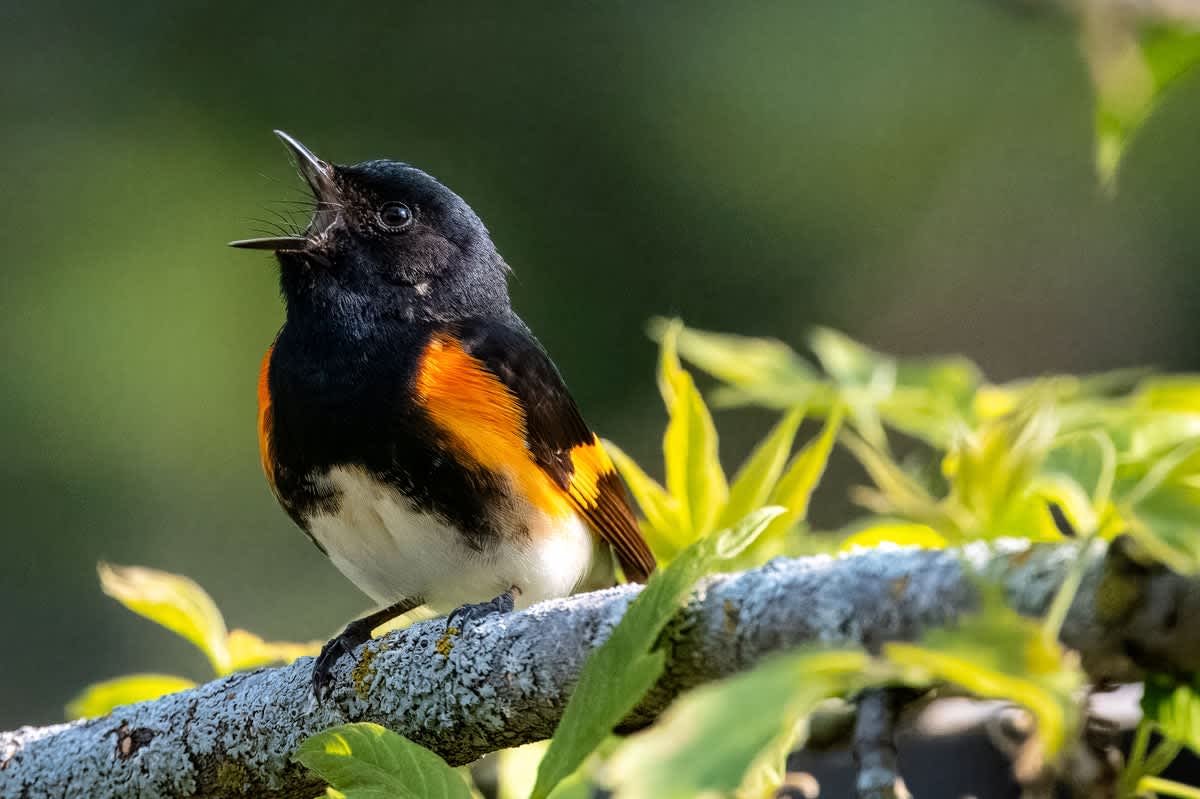Migrating Birds Sing to Team Up with Other Species
Songbirds may socialize across species during nighttime migrations
A singing American Redstart (Setophaga ruticilla).
Join Our Community of Science Lovers!
Tiny songbirds such as grosbeaks and warblers migrate thousands of miles, flying at night and resting during the day, to and from their wintering grounds—and unlike many larger birds, they forego flocks and travel separately.* But new research suggests they’re not entirely alone in the dark sky. Benjamin Van Doren, an ornithologist at the University of Illinois Urbana-Champaign, and his colleagues set up ground-based microphones at 26 sites across Eastern North America and collected more than 18,300 hours of bird flight calls. The researchers found that solitary migrating songbirds seem to cooperate across species and possibly share information with other solo travelers about who they were and what to watch out for ahead.
The findings, published on Wednesday in , add to growing evidence that interspecies social interactions may influence songbirds’ migratory behavior far more than was previously believed.
The conventional wisdom had been “that each bird is following its own internal instinct or its own experience,” Van Doren says. “If it’s not a young bird and has already [migrated] a few times, they definitely rely on memory and experience—but generally they’re just on their own.”
If you’re enjoying this article, consider supporting our award-winning journalism by subscribing. By purchasing a subscription you are helping to ensure the future of impactful stories about the discoveries and ideas shaping our world today.
“It’s really been unclear why exactly they are spending all this energy and all this effort calling while they’re migrating,” Van Doren says. “There must be some reason why or benefit to this behavior. Otherwise they’re just wasting energy.”
They found that individual birds from different species were flying near one another and calling out to each other using certain patterns, “more so than we could explain by chance,” Van Doren says. So there appeared to be some reason the birds were in proximity. The new study “potentially suggests that these birds aren’t completely on their own trying to find their way from Chicago to Argentina … and that maybe there’s actually some social information being exchanged among these billions of songbirds migrating at night, which would totally flip around our understanding of how songbird migration works.”
It’s still unclear exactly what information the birds may be communicating, Van Doren says. But researchers have some pretty good guesses. For instance, different bird species have different calls, but even within the same species, their “pings” vary across age or sex groups—suggesting that birds could be using such information to introduce themselves. Whatever the case, it’s highly likely that “staying in touch with other individuals could help them … navigate more effectively,” Van Doren explains. They could be exchanging knowledge about landing spots and tricky weather conditions such as fog or rain, for instance. “Migration is a very risky time, even for birds that have done it before.”
Researchers have previously observed that songbirds form “mixed-species flocks” while searching for food and avoiding predators during the day, Van Doren adds. The new study suggests such partnerships could play a more significant role than researchers realized. Additional studies will further test these hypotheses, hopefully by using more direct tracking methods, such as tagging specific birds to track them during migration.
“If we could take it from this big population-level scale and try to understand what the individual’s doing,” Pierce says, “It is going to be a key to understanding how birds are migrating.”
“To me, it speaks to the amazing complexity of how nature works,” Van Doren says, “and it’s exciting to be still learning new things about these well-known phenomena that are just spectacular.”
*Editor’s Note (1/16/25): This sentence was edited after posting to correct the examples of songbirds that migrate.
Gayoung Lee is Scientific American’s current news intern. A philosopher turned journalist, originally from South Korea, Lee’s interests lie in finding unexpected connections between life and science, particularly in theoretical physics and mathematics. You can read more about her here: https://gayoung-lee.carrd.co
Source: www.scientificamerican.com
